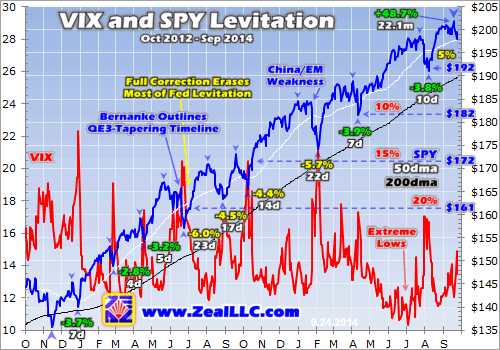 Since early 2013 the US stock markets have done nothing but rally, levitating thanks to the Fed’s oft-implied backstop. This incredibly unnatural behavior has left sentiment dangerously unbalanced, with hyper-complacency and euphoria running rampant. Only a major selloff can restore normal psychology. And with the Fed’s third quantitative-easing campaign ending, odds are high such a big downside event looms.
Since early 2013 the US stock markets have done nothing but rally, levitating thanks to the Fed’s oft-implied backstop. This incredibly unnatural behavior has left sentiment dangerously unbalanced, with hyper-complacency and euphoria running rampant. Only a major selloff can restore normal psychology. And with the Fed’s third quantitative-easing campaign ending, odds are high such a big downside event looms.
Stock markets are forever cyclical. Stock prices don’t move in straight lines forever, they endlessly rise and fall. Great cyclical bulls that earn investors fortunes are followed by brutal cyclical bears that create the best opportunities to buy low again. The perpetual cyclicality of the stock markets reminds me of Mark Twain’s famous weather quip. If you don’t like current stock prices, just wait a spell and they’ll change!
The rising and falling of stock markets is fractal in nature, repeating at different scales. There are great 17-yearsecular bulls and bears driven by valuations, the markets’ overarching cycles. Within them are still-large cyclical bulls and bears, generally lasting from 2 to 5 years each. And then in turn these are punctuated by smaller countertrend moves, corrections inside cyclical bulls and bear-market rallies in bears.
These mid-cyclical-bull selloffs are exceedingly important for the bulls’ health. When stock prices rise, the great sentiment pendulum swings ever farther towards the greed extreme of its arc. If the excessive optimism that rising stocks always create grows too unbalanced, all near-future buying is sucked in. So the stock rally soon burns itself out, leaving nothing but sellers. This dynamic is what breeds stock selloffs.
The serious risk today is that these selloffs tend to be proportional to the rallies that led into them. The longer stock markets climb without a major selloff to rebalance sentiment, the more unbalanced trader psychology becomes to the greed side. This necessitates commensurately larger and/or sharper selloffs to bleed off the excess euphoria and bring sentiment back into line. That means we are in for a doozy of one today!
For the better part of two years now, the American Federal Reserve has tirelessly worked to short-circuit every nascent stock-market selloff. Both by actively creating new dollars out of thin air to monetize debt, and by incessantly jawboning about further easing, the Fed convinced stock traders that it would be quick to respond to any stock-market weakness. So they bought and bought, nipping every selloff in the bud.
But with no real selloffs, sentiment couldn’t be rebalanced. Thus greed, euphoria, complacency, and even hubris flourished immensely. This pulled vast amounts of buying forward, effectively bullying far more investors into buying stocks than would’ve otherwise done so in normal markets. This so-called Fed Put led to the most distorted, overvalued, overextended, and risky markets we’ve seen since the early-2000 bubble.
This post was published at ZEAL LLC on September 26, 2014.

 Follow on Twitter
Follow on Twitter
Recent Comments